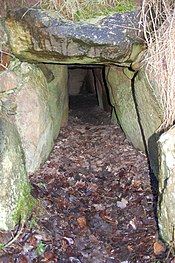Troldhøj (Stenstrup)
The Troldhøj of Stenstrup ( German Troll Hill also Troldstue called) is a in the Neolithic period (3500 to 2800 v. Chr.) Resulting double passage grave ( Danish Dobbelt- or Tvillingejættestue called). It is located between Højby and Lumsås , west of the hamlet of Stenstrup , at the foot of the Sjællands Odde peninsula in the north-west of the Danish island of Zealand . It dates from the Neolithic Age around 3500–2800 BC. And is a megalithic system of the funnel beaker culture (TBK). The passage grave is a form of Neolithic megalithic systems, which consists of a chamber and a structurally separated, lateral passage. This form is primarily found in Denmark, Germany and Scandinavia, as well as occasionally in France and the Netherlands. Neolithic monuments are an expression of the culture and ideology of Neolithic societies. Their origin and function are considered to be the hallmarks of social development.
About 10% of the 500 surviving Danish passage graves were built as double systems by assembling two chambers (here about 6.3 × 2.2 m and 6.4 × 2.8 m) on the narrow sides. Double-passage graves are only found in Denmark (57) and Sweden (3) mostly on Jutland and Zealand (e.g. Korshøj and Regnershøj ) and occasionally on Møn , Langeland ( passage grave in Tvedeskov ), Fyn and Samsø (e.g. Rævebakken ).
The klekkende høj is (see Fig.) On Mon the only example of a long chamber that is so divided that the longitudinal axes form a straight line. Usually, as is the case with Troldhøj, they form an obtuse angle and, with their long corridors, adapt to the round hill measuring 26 m here.
description
The approximately north-south oriented passage grave of Stenstrup contains two oval chambers, each of which has its entrance . The only stone that forms the right wall of the left chamber is also the left wall of the right chamber. So the whole thing represents a large chamber with two entrances separated by a central wall. The special thing here is that two cap stones above the chambers consist of the same split boulder , whereby it was possible to prove that the splitting of stones was already part of the technical possibilities of the belonged to stone age builders in northern Europe. No mechanical aids were used for splitting, but fire and water. The extensive finds are exhibited in the small museum in Stenstrup and in the National Museum.
Some structural details are particularly interesting. The chambers each have 14 bearing stones, plus the dividing stone and four cap stones each. The transition from the corridors to the chambers is designed as a door lintel , with the lintel stone and its two supporting stones protruding a little into the chambers. Only this infrequent arrangement enables the support of the two middle capstones which, as yokes, only just rest on the lintel stone or on the indented bearing stone next to it. Here the endeavor to build the largest possible system with the available material becomes clear. Both aisles are stepped in the rear area in order to provide a contact surface for a locking device. The door stone in the north corridor was preserved. In the south corridor there are 10 bearing stones and four (one or two missing) cap stones. In the northern corridor, 11 bearing stones and three (one or two missing) cap stones have been preserved.
See also
literature
- Peter V. Glob : prehistoric monuments of Denmark. Wachholtz, Neumünster 1967 pp. 71, 73
- Karsten Kjer Michaelsen: Politikens bog om Danmarks oldtid (= Politikens håndbøger. ). Politiken, Copenhagen 2002, ISBN 87-567-6458-8 p. 205
Individual evidence
- ^ Johannes Müller : Neolithic Monuments and Neolithic Societies. In: Hans-Jürgen Beier , Erich Claßen, Thomas Doppler, Britta Ramminger (eds.): Varia neolithica VI. Neolithic Monuments and Neolithic Societies. Contributions from the meeting of the Neolithic Working Group during the annual meeting of the North-West German Association for Ancient Research in Schleswig, 9. – 10. October 2007 (= contributions to the prehistory and early history of Central Europe. Vol. 56). Beier & Beran, Langenweißbach 2009, ISBN 978-3-941171-28-2 , pp. 7-16, here p. 15.
Web links
- http://www.kulturarv.dk/fundogfortidsminder/Lokalitet/104810/ (last accessed on December 3, 2012)
Coordinates: 55 ° 55 ′ 51 ″ N , 11 ° 32 ′ 28.5 ″ E



